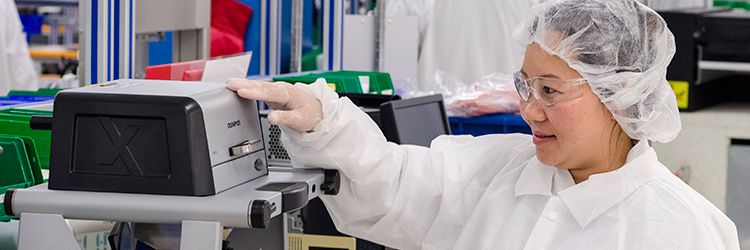Applications scientists from our X-ray fluorescence (XRF) team were on hand at ECNDT 2018 in Gothenburg, Sweden discussing interesting topics including screening glass and measuring coating thickness.
You can check out the papers and presentations below to catch up on what you missed.
Coating Measurement Using Handheld X-Ray Fluorescence
Presenters: Karen Paklin, Peter Faulkner, and Dillon McDowell
Abstract
Handheld X-ray fluorescence (HHXRF) can be used to measure coating thicknesses, with advantages in precision and portability compared to other technologies. Analyzing coatings applied over large surface areas often requires destructive procedures for benchtop analysis. HHXRF overcomes this limitation and provides a nondestructive coating thickness testing capability.
A calibration built into the instrument’s user interface makes it easy to use a certified standard to analyze and determine up to three layers of accurate and precise coating thicknesses. HHXRF coating measurements, which are independent of the substrate material, enable a user to freely analyze any deposited coating comprised of elements titanium (Ti) through plutonium (Pu). Because of the large elemental range of analysis, many corrosion, wear, and adhesion coatings determined from labs near the analysis site can benefit from the precise results returned by HHXRF.
The physics behind the coating analysis is driven by the Lambert-Beer law of absorption, where the intensity of the X-ray entering a sample is highest as it enters the first layer but decreases as it travels through the layer. Upon entering
Screening for Ceramic and Leaded Contaminants in Glass Recycling Streams Using Handheld X-Ray Fluorescence (HHXRF) Analyzers
Presenters: Dillon McDowell and Alex Thurston
Abstract
Material recovery facilities (MRFs) typically use magnetic and optical sorting systems to separate glass cullet from recycled glass. However, these systems are not effective at screening glass ceramic and leaded constituents from cullet streams. These contaminants lower the value of glass cullet to glass manufacturers, as they represent manufacturing and safety concerns. Handheld X-ray fluorescence (HHXRF) analyzers are widely used in various recycling and manufacturing settings to quickly provide chemical composition on a variety of elements, even to the range of 1–10 ppm. We compare HHXRF analysis of prepared glass samples to laboratory assayed glass standards used by MRFs and glass manufacturers. Our results show that HHXRF can detect even small quantities (<100 ppm) of ceramic elements in glass and glass cullet streams in situ. Our results also show HHXRF detection of leaded contaminants and coloring agents (Fe, Cu, etc.) in cullet streams. We also demonstrate that the same technique can be applied to in-line monitoring systems to analyze material streams for the same constituents.
Download the Paper
Related Content
Does this Glass Pass? Using XRF to Screen for Ceramic and Lead Contaminants
How To: Add a Coating Model on Your Vanta Analyzer
Through Thick and Thin: Using XRF to Measure Coating Thickness
Get In Touch

